Articles of 2005
Black Boxing Back in Milwaukee
Jack Johnson wasn¹t the only boxer to suffer from “Unforgivable Blackness,” to use the haunting title of the Ken Burns documentary about the first African-American heavyweight champion.
For the first third of the 20th century, when Milwaukee, Wisconsin was one of the biggest prize-fighting venues in the country, black fighters were barred from appearing there altogether.
It wasn’t until 1930 that boxing in Wisconsin was desegregated for good.
Most states barring matches between black and white fighters did so ostensibly out of fear of inciting the kind of riots that killed up to 26 persons following Johnson’s win over white ex-champion James J. Jeffries in their July 4, 1910 title fight.
No disturbances were reported in Milwaukee, and to keep it that way Mayor Emil Seidel wanted film of the Johnson-Jeffries fight kept out of local theaters “in the best interests of our city and youth in particular.”
There was no such concern less than two years later, on April 13, 1912, when six blindfolded black men whaled away at each other until only one was left standing in a ring at the Milwaukee Athletic Club.
The winner of the “Battle Royal,” as these demeaning spectacles indigenous to the Deep South were called, received a pork – or ‘poak,’ as one newspaper reported in the vernacular – sandwich.
When the governor appointed a commission to oversee legalized boxing in Wisconsin in 1913, its chairman was Walter H. Liginger, former president of the MAC, Amateur Athletic Union, and a honcho of the 1904 Olympic Games in St. Louis.
Under his direction, Wisconsin became the model for other states setting up their own boxing commissions, and the world¹s top fighters were welcomed here to exhibit their skills and fatten their wallets.
The white ones, anyway.
Like Jack Johnson, Sam Langford is regarded by boxing experts as one of the greatest fighters in ring history. But when local promoters tried to match him and Sam McVey, another outstanding black heavyweight of that era, the commission drew the color line.
“We have a rule on our books that negroes cannot box in this state,” said Liginger, “and we do not intend to waive it for anyone. Negro boxers have done more to put boxing in disrepute than all the white boxers in the game, and whenever there is a scandal, invariably there is a colored gentleman involved.”
In fact, the only scandal theretofore involving a black fighter in Wisconsin occurred on December 8, 1899. Local white heavyweight George Lawler and a black fighter called “Klondike” went eight rounds at the MAC. It was an ugly, foul-filled bout, and for years afterwards whenever anyone voiced concerns about mixed matches, they invariably pointed back to Lawler vs. Klondike.
They conveniently never mentioned, however, that every contemporary newspaper account of the match laid the blame for its putridness exclusively on the white guy.
Decried as “unjust, un-American, and an insult of insufferable injury” by the local Colored Citizen’s Liberty League, Liginger’s racist injunction nevertheless stood until 1918, when the commission finally reluctantly let Sam Langford darken the door of the Milwaukee Auditorium.
Then 47, Langford and another ancient black heavyweight, Jeff Clark, wheezed through 10 dull rounds in a match approved only because the proceeds went to the Red Cross.
According to Liginger, the bout proved he had been right to keep state rings lily white.
‘It was the first and last match between negroes in Wisconsin,” he declared. “They have tried and tried to break in here and finally were accommodated, but the showing last night has convinced the people that they want no more of them.”
It stayed that way here even after other states lifted their bans on black fighters. In 1926, Tiger Flowers became the first African-American since Jack Johnson to win a world title when he beat Harry Greb for the 160-pound belt in New York City.
The new middleweight champion was no relation to the fighter from New Rochelle, New York who a year later claimed the “World’s Colored Lightweight Championship.” Bruce Flowers’ boxing skills reminded old-timers of Joe Gans, a turn-of-the-century black lightweight champion so clever they called him “The Old Master.”
In six years as a pro, Flowers had reportedly earned $200,000 in the ring. Outside of it, he was a quiet, family man who prayed before every fight that no harm would come to his opponent.
Such un-Johnson-like behavior probably persuaded Liginger to go along when promoters proposed Flowers for an April 11, 1930 match against local favorite King Tut at the Auditorium – as well as that Tut’s originally-scheduled opponent and two substitutes had all fallen out just four days before the fight.
“I see no reason for discriminating against a negro fighter if he is capable of putting up a good fight,” the chairman said in newspaper stories heralding the historic sea change coming to Wisconsin boxing.
When Flowers hit town on the Tuesday before the Friday fight, his public workouts at Morgenroth’s gym on W. Water St. drew crowds. The attention was old hat to him. Two years before, Flowers had integrated boxing in Michigan by beating Spug Meyers in Detroit.
There hadn’t been a sellout for a boxing card at the Auditorium in almost a decade, but 7,900 fans packed it for the Flowers-Tut fight, and thousands more were turned away. The next day’s Milwaukee Journal ran a panoramic photo of the wall-to-wall spectators surrounding the ring in which the first black-and-white match here in 30 years went on until a low punch by Tut brought his disqualification in the fifth round.
No riot ensued, just applause for Flowers (“a mighty sweet colored fighter,” said the Milwaukee Sentinel), who fought in the city three more times and deserves to be remembered for making the Sweet Science in Wisconsin an equal-opportunity sport.
-
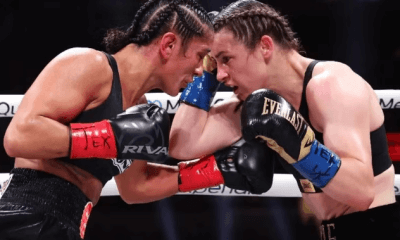
 Featured Articles4 weeks ago
Featured Articles4 weeks agoResults and Recaps from New York Where Taylor Edged Serrano Once Again
-
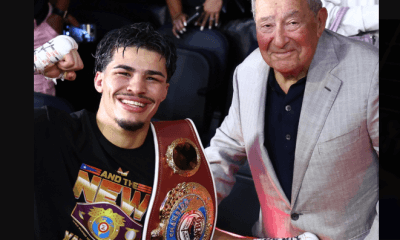
 Featured Articles1 week ago
Featured Articles1 week agoThe Hauser Report: Zayas-Garcia, Pacquiao, Usyk, and the NYSAC
-
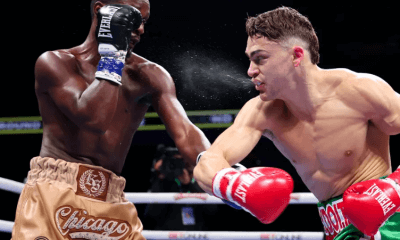
 Featured Articles4 days ago
Featured Articles4 days agoOscar Duarte and Regis Prograis Prevail on an Action-Packed Fight Card in Chicago
-

 Featured Articles4 weeks ago
Featured Articles4 weeks agoResults and Recaps from NYC where Hamzah Sheeraz was Spectacular
-
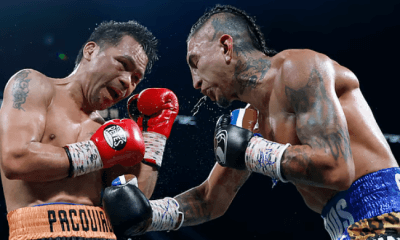
 Featured Articles3 weeks ago
Featured Articles3 weeks agoManny Pacquiao and Mario Barrios Fight to a Draw; Fundora stops Tim Tszyu
-
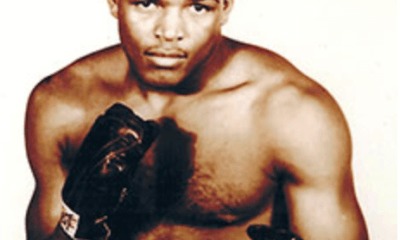
 Featured Articles4 weeks ago
Featured Articles4 weeks agoPhiladelphia Welterweight Gil Turner, a Phenom, Now Rests in an Unmarked Grave
-
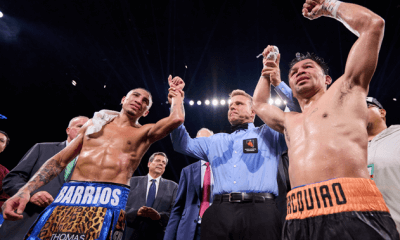
 Featured Articles2 weeks ago
Featured Articles2 weeks agoArne’s Almanac: Pacquiao-Barrios Redux
-

 Featured Articles1 week ago
Featured Articles1 week agoRemembering Dwight Muhammad Qawi (1953-2025) and his Triumphant Return to Prison














